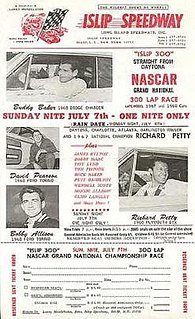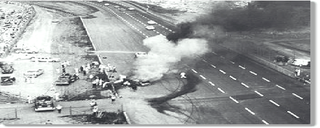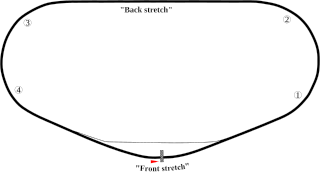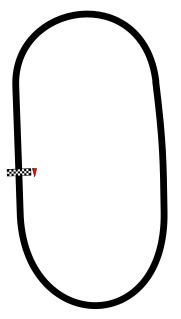Related Research Articles

DeWayne Louis "Tiny" Lund was an American stock car racer. He was a journeyman racer-for-hire in the top level NASCAR Grand National Series, running partial seasons for a number of years, including a victory in the 1963 Daytona 500. Lund saw his greatest success in the NASCAR Grand American Series, where he was the season champion in three of the four full years the series was run – Lund won 41 of the 109 Grand American events that ran.
The 1968 Fireball 300 was a NASCAR Grand National Series event that was held on May 5, 1968, at Asheville-Weaverville Speedway in Weaverville, North Carolina.

The 1961 World 600, the second running of the event, was a NASCAR Grand National Series event that took place on May 28, 1961, at Charlotte Motor Speedway in Concord, North Carolina. Chris Economaki called the race in one of the few televised NASCAR races of the 1960s. A series of two qualifying events took place on May 21 to determine the starting grid for this event.

The 1968 Islip 300 was a NASCAR Grand National Series event that was held on July 7, 1968, at Islip Speedway in Islip, New York.
The 1968 Beltsville 300 was a NASCAR Grand National Series event that was held on May 17, 1968, at Beltsville Speedway in Beltsville, Maryland.
The 1963 Sandlapper 200 was the site of Richard Petty's 25th NASCAR Grand National win for Petty Enterprises.
The 1963 NASCAR Grand National Series was an American stock car racing competition. It was the fourteenth running of what is now called the Monster Energy NASCAR Cup Series.
The 1965 Greenville 200 was a NASCAR Grand National Series event that was held on April 17, 1965, at Greenville-Pickens Speedway in Greenville, South Carolina.

The 1964 World 600, the fifth running of the event, was a NASCAR Grand National Series event that took place on May 24, 1964, at Charlotte Motor Speedway in Concord, North Carolina.

The 1966 Firecracker 400 was a NASCAR Grand National Series event that was held on July 4, 1966, at Daytona International Speedway in Daytona Beach, Florida.

The 1967 Carolina 500 was a NASCAR Grand National Series event that was held on June 18, 1967, at North Carolina Motor Speedway in Rockingham, North Carolina.
The 1956 Buddy Shuman 250 was a NASCAR Grand National Series event that was held on November 11, 1956, at Hickory Speedway in Hickory, North Carolina.

The 1967 Gwyn Staley 400 was a NASCAR Grand National Series event that was held on April 16, 1967, at North Wilkesboro Speedway in North Wilkesboro, North Carolina.
The 1968 Columbia 200 was a NASCAR Grand National Series stock car race that was held on April 18, 1968, at Columbia Speedway in Columbia, South Carolina.

The 1966 Southern 500, the 17th running of the event, was a NASCAR Grand National Series event that was held on September 5, 1966, at Darlington Raceway in Darlington, South Carolina.
The 1966 Buddy Shuman 250 was a NASCAR Grand National Series event that was held on September 9, 1966, at Hickory Motor Speedway in Hickory, North Carolina.

The 1967 Atlanta 500 was a NASCAR Grand National Series event that was held on April 2, 1967, at Atlanta International Raceway in Hampton, Georgia.
The 1959 Western North Carolina 500 was a NASCAR Grand National Series event that was held on August 16, 1959, at Asheville-Weaverville Speedway in Weaverville, North Carolina. This event took place after the 1959 Nashville 300; which was set at Nashville Speedway in Nashville, Tennessee.

The 1957 Virginia 500 was a NASCAR Grand National Series event that was held on May 19, 1957, at Martinsville Speedway in Martinsville, Virginia.
Jacksonville Speedway was a dirt track located in Piney Green, North Carolina just southeast of Jacksonville, North Carolina. The speedway was a half-mile dirt track that hosted two NASCAR Grand National Series races in 1957 and 1964.
References
- ↑ "1966 Columbia 200 weather information". The Old Farmers' Almanac. Retrieved 2012-10-11.
- 1 2 3 "1966 Columbia 200 information (third reference)". Ultimate Racing History. Retrieved 2010-12-05.
- 1 2 3 4 5 6 7 8 9 10 11 "1966 Columbia 200 information". Racing Reference. Retrieved 2010-12-05.
- ↑ Columbia Speedway page of Racing-Reference website , retrieved 8 May 2007.
- ↑ Fielden, Greg, "NASCAR Cleans Up", Speedway Illustrated, September 2004.
- ↑ "1966 Columbia 200 information (second reference)". Everything Stock Car. Archived from the original on 2011-07-10. Retrieved 2010-12-05.
- ↑ "1966 Columbia 200 crew chief information". Racing Reference. Retrieved 2017-06-11.
| Preceded by 1966 Hickory 250 | NASCAR Grand National Series Season 1966 | Succeeded by 1966 Greenville 200 |